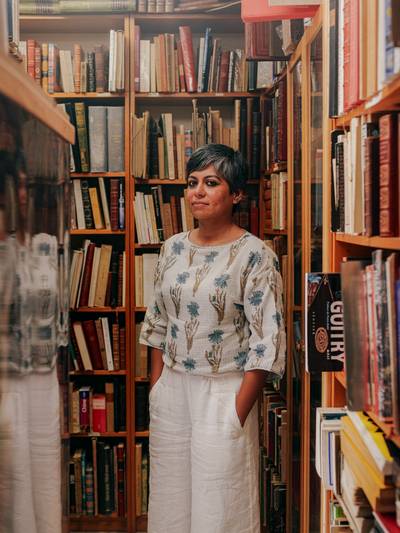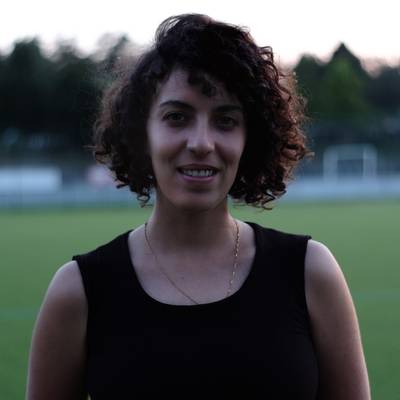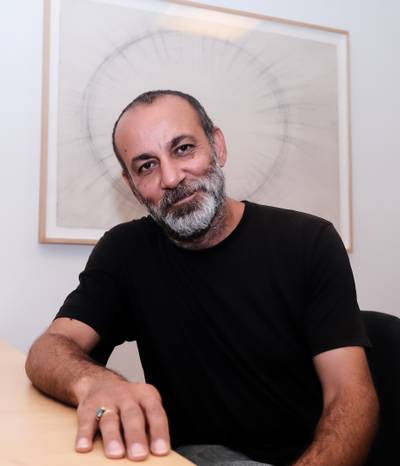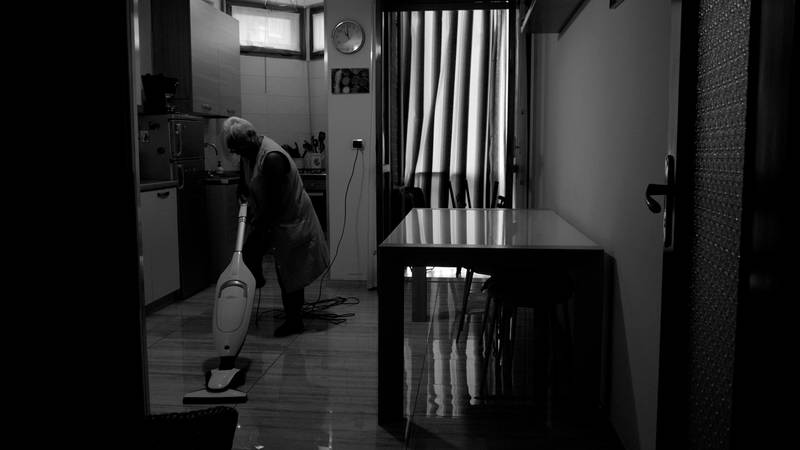

Liryc Dela Cruz, Il Mio Filippino; For Those Who Care To See © Courtesy of SPAZIO GRIOT and the artist
Helia Hamedani is an art historian and an independent curator with a particular interest in the intercultural field. She has collaborated with non-profit cultural associations and curated exhibitions in both Iran and Italy. She has also co-curated projects for inclusion and education through art, for public schools in Rome. She is a PhD student in Art History at Sapienza University of Rome and has conducted courses on contemporary art in Tehran. Her doctoral research focuses on the studies and perspectives of Ruyin Pakbaz, intending to analyze the state of Iranian art historiography over the past 60 years.
I got to know Liryc back in his first year in Italy, when he arrived in Rome. We used to live in the same neighbourhood for a short period of time. The first work I saw of him was during a casual screening among friends at the Noworking1 Office of Stalker2. It was a slow, almost dreamlike black and white documentary that, over the years, I’ve come to recognize as his distinctive style and signature. Notes From Unknown Maladies was about the daily life of an older woman living alone and suffering from a nervous breakdown. She wandered around the house, hanging laundry, watering plants, haunted by random memories, shouting at invisible dictators, sometimes praying or laughing. The images felt fragmented, much like the memories of a person losing their memory. The woman in the film was Liryc’s grandmother, she had become a metaphor for the history of the Phillipines, once colonized, exploited, and now losing her memory. After years of following Liryc’s journey, I’m now more and more fascinated by how he incorporates a straightforward, individualized tale into the collective and political narratives that we all experience.
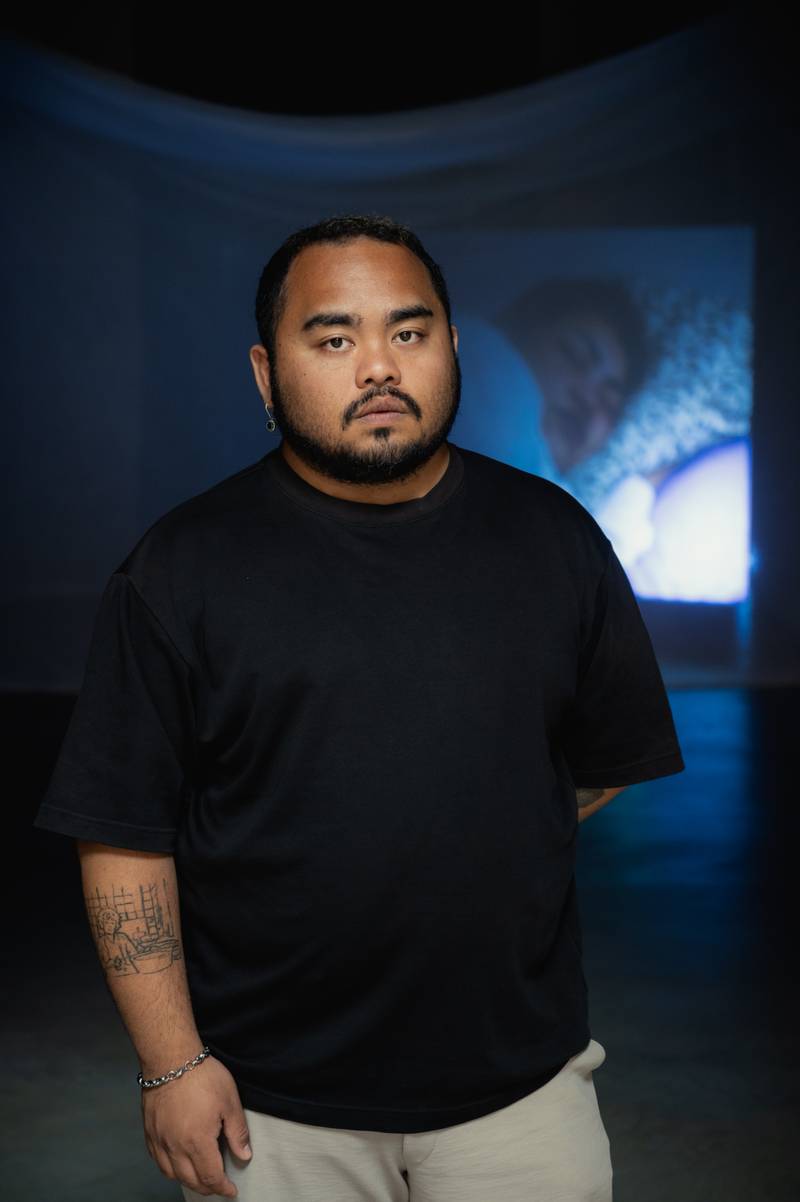

Portrait of Liryc Dela Cruz by Andrea Pizzalis
HELIA: Your artistic practice initially began with cinema, but in recent years, you have expanded your medium to include performance, community gatherings, dance, and indigenous practices. Could you elaborate on the evolution from working primarily with moving images to now involving moving bodies in your practice?
LIRYC: Actually, performance is not new to me, as before my formal engagement with cinema, I was a community dancer. I grew up in a place in the southern Philippines where we do a lot of street dancing as a part of our tradition. So, from elementary to high school, I was part of a dance group. We performed indigenous dances every time there was a feast, not only in our hometown but also in the region of South Cotabato. It is part of our education to learn indigenous and folk dances and movements that derive from indigenous gatherings. I am reconnecting these practices, trying to reflect and rethink again how I can put this into my current practice with moving images or cinema.
Can you tell me more about these indigenous dances?
Yes, we learn these dances not only in the community but also in school. I think it’s part of our lives and community gatherings. During the celebrations, we perform Madal Be’lan, a dance based on the gathering of indigenous tribes in the region. Before the feast, we practice a lot in different groups, preparing ourselves, and during the festival, you can see at least twenty different groups dancing different choreographed pieces together. Somehow it’s like a carnival, and we call it Street Dancing. For example, in my hometown, there is a very popular festival called T’nalak (which refers to a sacred cloth). Women from the T’boli tribe who dream about the patterns for the craft make the cloth. The day after, they weave the patterns of their dreams.
In my last project, I tried to revisit all these performances. One of my consultants that I lost during COVID-19, Warny Bautista, was my dance teacher in elementary and high school. That’s why it’s very significant to me; it’s not just a dance; it’s part of the history and memories rooted in that land and is also part of me.
You have done multi-year and long research on the Philippine diaspora, specifically about caregivers who have come to Italy for domestic work since 2017. How did you start this long research project?
The starting point of my research was when I started to learn from Filipino workers how to clean in 2017. I had just arrived in Italy and thought this would be my new path, which I had to embrace and accept as it helped me survive here economically. Cleaning was the most available work that I could get in this territory. So I did it. Different Filipino domestic workers have trained me. They’re a welcoming and supportive community. But I felt that their imagination had been structured by agreements made between our country and the country of employment to think that this was the only opportunity they could have. Whenever I talked to them about my desire to continue my artistic work, they rejected the idea. Saying things like “I was also a teacher in the Philippines, but here, I am the cleaning worker”. I started to challenge them. I couldn’t stop my sense of curiosity, even though I wanted to disconnect from my artistic practice. I was still hungry. I was still looking for ways to reconnect all these stories. So I asked for their consent and permission to start by filming them. At first, I just wanted to create an archive of how a body is taking care of the space and the geography where they are residing.
I thought this could be my project because I’ve been experiencing it for a year. Of course, it’s not comparable; they have been here for at least 25 years, but in one year of experiencing bureaucracy and racial discrimination, that suffering was clear to me. I thought I could do something, but not to save them, as I hate saviorism, but to try to do something by questioning.
I started to film them and hear their stories. I am not so interested in their personal stories, which may create a collective narrative of suffering. I think the most important thing is their invisibility. Because of that invisibility, they suffer here in Italy. I thought this could be my project because I’ve been experiencing it for a year. Of course, it’s not comparable; they have been here for at least 25 years, but in one year of experiencing bureaucracy and racial discrimination, that suffering was clear to me. I thought I could do something, but not to save them, as I hate saviorism, but to try to do something by questioning. My mom is a cleaning worker; she was also a domestic worker in the Middle East for a few years. Therefore, it became a very personal work for me. That was the beginning, and then I had the supportive space of Stalker and Morteza Khaleghi. And then there was the crucial person to this project, Francesca Corona, the former Artistic Director of Teatro di Roma, who selected us to be part of their project and programme in Teatro di Roma. After that, I had two residencies there, which helped the project travel to France, Moldavia, and Belgium for residency. In 2020, Il mio Filippino received the Torino Social Impact Art Award from Artissima in Turin.
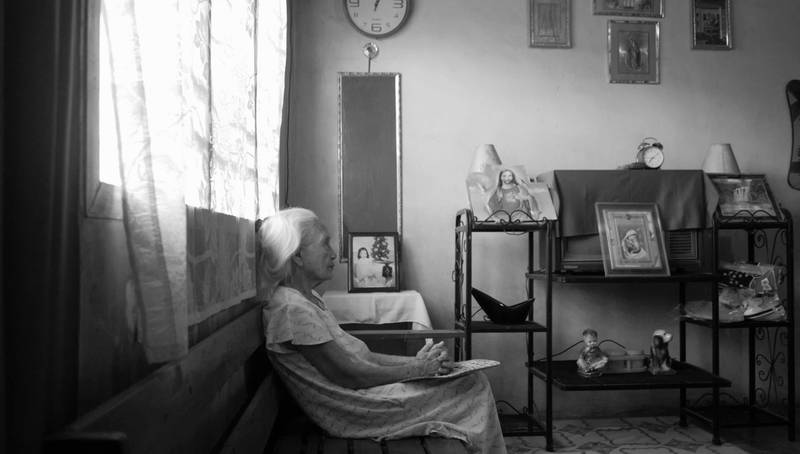

Liryc Dela Cruz, Notes From Unknown Maladies, 2018
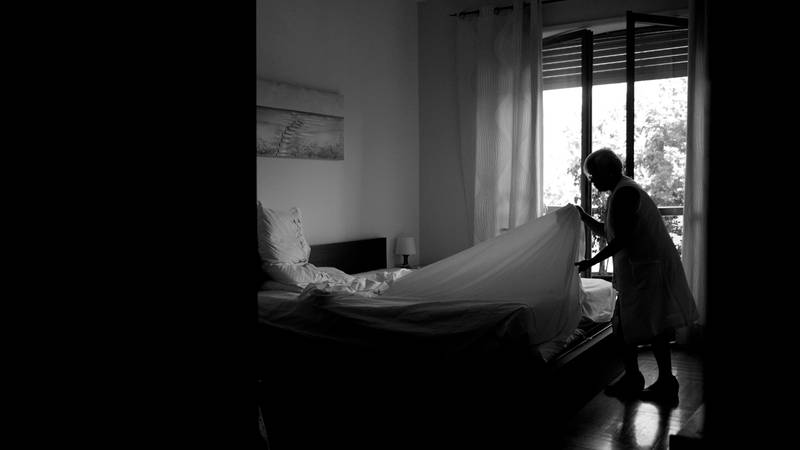

Liryc Dela Cruz, Il Mio Filippino; For Those Who Care To See © Courtesy of SPAZIO GRIOT and the artist
Now that I know how you started and developed the idea, I am curious to know how you found your collaborators and how you worked together.
When we started this project, the people who taught me how to clean were very important in our collective thinking, giving me initial ideas. Then in 2018, I met Benjamin Vasquez Barcellano Jr., who is an actor but also works as a domestic worker in Italy. He was a very strong figure for this project because he helped me connect closely with different Filipino communities in Italy. With Benjie, Jenny Guno-Llanto, Sheryl Palbacal, and other Filipino collaborators, we are continuously working on pushing this research, engaging different institutions, networks and groups of Filipino workers in different cities. We started to create networks in Torino, Milano, Calabria and Rome of course.
We created a connection circle, not with a big community, because when we started, it was also during the COVID19 and it was really hard to connect with people. In Torino, we met Tess Magallanes, who was very welcoming and opened her community to us. She has been a domestic worker, not only in Italy but also in Hong Kong and Singapore. And when she knew about our project, her insistence and generosity made me feel that this work was really important for them as well. It was clear to all of us that our community is really invisible. And by our community, I’m not only talking about the Filipino community but also the community of care and cleaning workers. Because while this project is called “Il mio, Filippino” (the way Italians refer to cleaning and care workers), I have also encountered, through my Filipino collaborators, other nationalities.
The title of your research: “Il Mio Filippino,” challenges the stereotypical association of the Filipino community with domestic labor in Italy. What message or critique are you trying to convey through this body of work?
The title came from my conversations with 3-4 Italian friends coming from rich families, not the nouveau riche; maybe it’s better to say from bourgeois family backgrounds. They told me it is a common way to call their care or cleaning workers: my Filipino, even if they are from other nationalities. That made me think again about when the Filipinos arrived here. What was the process of their arrival like? What were the agencies?
I realized that after being in residencies and engagements in the contemporary art scene, the West is so eager to fund this process of decolonization without being accountable for what they did. They feel that we are all in the healing stage already, but clearly the wound is still open. I think that without being accountable and finding ways in which we can heal together, decolonization is not possible.
I’m also challenging Filipinos to reclaim this word that they are the Filipino of themselves and not just the Filipino of anybody. My problem is that I know Italians and I have Italian friends, but it seems that they are in a sort of denial. I am not surprised because this country is not so accountable for its colonial past and how racist it is. There is a Filipino character on Italian TV who, for a long time, has been portrayed by Marco Marzocca as a gullible Filipino worker who continuously commits mistakes and is always confused. There is also a “funny” song called “Filippino Rock” by Elio e le storie tese. It’s racist, and you see how they frame an ethnicity and create stereotypes.
It’s clear that your work delves into the deep-rooted impact of colonization on the Philippines, a country that endured centuries of colonization by both Spain and the United States. However, in today’s world, all the messages can be commodified, as after Covid19 the issue of care became fashionable in contemporary art. Decolonizing today is also quite simplified. How do you navigate this complex history and the challenge of ensuring that your artistic message goes beyond mere branding?
Yeah, first of all, I don’t believe that we are decolonizing right now. I really don’t, and it’s clear. Right now, I am more interested in the tools that we are creating to help other people understand decolonization. For example, in communicating with Filipino workers that I am collaborating with right now and also with people like my mom and my aunts in the Philippines who don’t understand colonization and decolonization enough or in a deeper sense. I realized that after being in residencies and engagements in the contemporary art scene, the West is so eager to fund this process of decolonization without being accountable for what they did. They feel that we are all in the healing stage already, but clearly the wound is still open. I think that without being accountable and finding ways in which we can heal together, decolonization is not possible. It’s about how I can explain this to my Filipino collaborators that I’m working with right now without undermining their capacity. Otherwise, we will just be 1% of people talking about decolonial practices, and that’s how it becomes a trend.
I remember another institution also contacting me, saying maybe we can include you in our program to talk about care practices or hospitality. I asked them, Should you? How do you know my work? And the response was because we read in your bio that this is the focus of your work. I said, I’m sorry, I’m not going to engage with you.
They have the money, they have the power, and they have the privilege to fund all of these things. But when you ask them about the process, like, Why are you engaging with this? The response is nothing. There’s no real connection with it. I think Il mio Filipino with Teatro di Roma, Artissima, and the last residency in Macro-Mattatoio have already been successful enough; maybe I can jump to another project. I don’t want to fall into the trap of contemporary art, the dark part, where it exoticizes and makes decolonization a metaphor to save the colonizers and western guilt for what they have done in our country. Also to hasten their healing process, so they can avoid it and just get away with it.
I’ve always asked my collaborators what they want to do if one day they go back to the Philippines. They always said to me: I want to be in my hometown, on our farm, and do nothing.
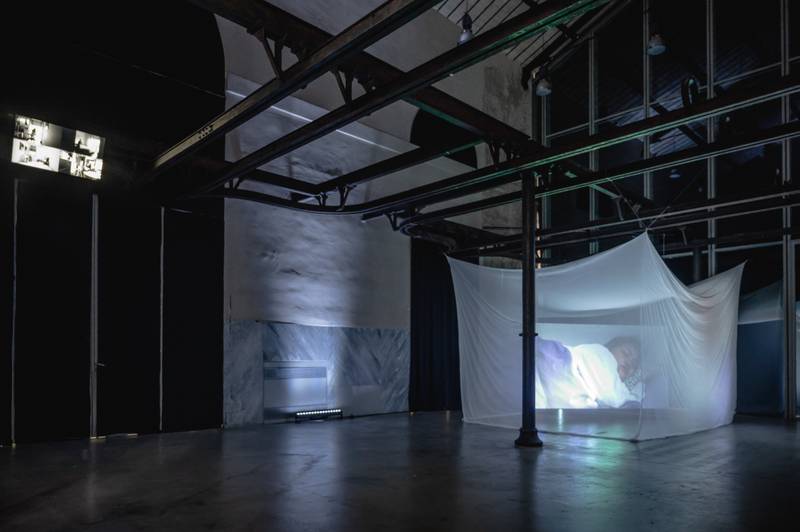

Liryc Dela Cruz, Il Mio Filippino; For Those Who Care To See, Installation view, Mattatoio Rome, Courtesy the artist and SPAZIO GRIOT © Andrea Pizzalis, 2023
In your latest show for Macro-Mattatoio you also highlighted the notion of leisure time/rest for Philippine domestic workers. In the installation, in the margins of the space, there are small monitors, like surveillance monitors, showing black and white videos of cleaners working, while the central space is dedicated to a woman who is sleeping inside a mosquito net. What is it about?
Prior to this exhibition, I already had a residency with Mattatio that was about care and hospitality (the title of the residency was Prender-si cura). The focus of that work was on the myth of rest and questioning the idea of rest for each of us.
I am going through the text of Antonio Pigafetta, an Italian guy who went to the Philippines with Ferdinand Magallanes, who colonized the Philippines. And in one of his diaries, during the first encounter, he described how they saw the Filipinos relaxing at the shore and doing nothing. And for westerners, this act of doing nothing is laziness. But when I go back to this memory, it’s actually the act of rest. This is when your body is connected with the ground, with the land, and with the soil to recharge you again. Because in the precolonial Philippines, the way their bodies were working was through reciprocity—the reciprocation of care and love with nature and the things around them. In this way of resting, when your body is on the ground doing nothing and just resting, you also give time to the environment and to the land to rest and heal. For my last show, after tons of brainstorming with my curators, Johanne Affricot, Eric Otieno Sumba, and their team from Spazio Griot, we arrived at this decision on what to present in the exhibition. It’s also because I’ve always asked my collaborators what they want to do if one day they go back to the Philippines. They always said to me: I want to be in my hometown, on our farm, and do nothing.
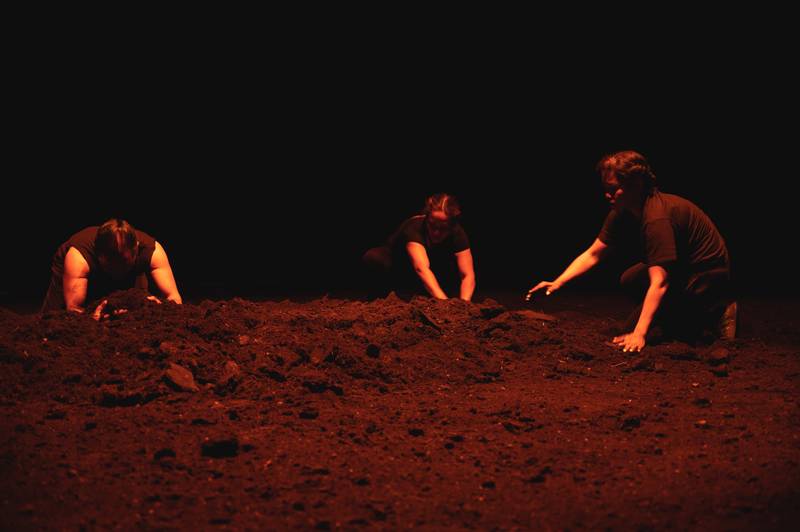

Benjamin Vasquez Barcellano Jr., Jenny Guno-Llanto and Sheryl Palbacal, Il Mio Filippino Performance (2023), Mattatoio, Rome, courtesy SPAZIO GRIOT and Liryc Dela Cruz, © Andrea Pizzalis
It was in our brainstorming with Anna Daneri, one of my mentors. We thought that showing the trajectory of the research could be the skeletal framework of the exhibition, and then I pitched it to the team at Spazio Griot. For me, this central space also gives the idea of protection, showing that we are going in the direction of long term research. So I decided to have this central image of a woman resting at her own pace, in her own time, breathing, resting, and being protected with a mosquito net.
You have another performance around the theme of care presented during your fellowship with TBA 21 Ocean Fellowship. Can you tell us more about that experience and what you brought to Venice?
I was part of the TBA 21 Ocean Fellowship. I participated in it with a project entitled: Ocean as a Space of Perpetual Care. The idea was based on the hospitality of indigenous Filipinos who took care of colonists who were poisoned. The story opens with the Magellan expedition, a Spanish expedition to the Moluccas (the land of spices) that Portuguese explorer Ferdinand Magellan planned and led. When the colonists were stealing spices in Guam and the Moluccas, the indigenous people poisoned them, so they had to find another land. When they arrived on the shores of the Philippines in Homonhon, they saw indigenous people welcoming them and waving their hands. When they arrived, indigenous people gave them fish, took care of them, and healed them. This was the beginning of the story; they understood these people were very kind, so it could be easy to colonize them. With my collaborators, Filipino domestic workers, we put soil in the port of Venice and made a carpet of soil. Then we invited people to join us, and we offered them food. We told them this land was the land of our ancestors, who taught us about receiving and taking care of people. On that carpeted soil, together we told the strangers who joined us stories about how our ancestors accepted strangers and fed them without thinking that soon they would harm our land, our country, and our people. And then after that, we carried the soil. We carried this carpet with the soil on it and made a procession in Venice. We are still thinking about repeating this performance at the borders by covering the borders with this soil and staying there together to welcome people who arrive. Without questioning or profiling who is who, just for a while, make people feel that creating a safe land is possible.


